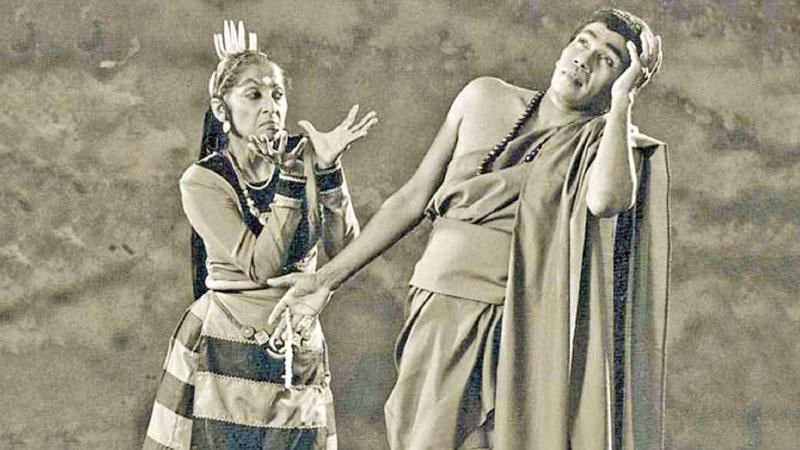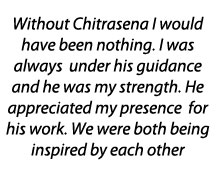
Vajira Chitrasena… The name is synonymous with Sri Lankan ballet and traditional dancing. But her substance wasn’t solely a one-dimensional presence as a dancer; rather it was her multi-faceted personality that saw her excelling in choreographing, directing, producing and teaching.
 The audience knew her when she was just 15 years; a young girl whose exotic beauty matched her talent. Groomed and moulded by her guru-legendary doyen of dance, Chitrasena; who later became her beloved husband. The duo broke tradition and reformed Sri Lankan traditional dance, which was lacking creativity and innovation.
The audience knew her when she was just 15 years; a young girl whose exotic beauty matched her talent. Groomed and moulded by her guru-legendary doyen of dance, Chitrasena; who later became her beloved husband. The duo broke tradition and reformed Sri Lankan traditional dance, which was lacking creativity and innovation.
 Born in Kalutara to a Sinhala, Buddhist family on March 15, 1932, Vajira was a student both at the Kalutara BalikaVidyalaya and Methodist College, Kollupitiya.Vajira’s mother N.C.Perera, was a teacher and her father was an accountant at the Kalutara Urban Council.
Born in Kalutara to a Sinhala, Buddhist family on March 15, 1932, Vajira was a student both at the Kalutara BalikaVidyalaya and Methodist College, Kollupitiya.Vajira’s mother N.C.Perera, was a teacher and her father was an accountant at the Kalutara Urban Council.
Vajira’s mother had wanted her to learn Sri Lankan traditional dancing and before she met Chitrasena she trained under many teachers but none of them had provided her a vision for life. Therefore, she continued to dance to the requirements of the school curriculum and her first two teachers were Anangalal Athukorala and Welgama.
Her parents were keen theatregoers and promoters of the oriental arts, especially, performing arts, and that is how Chitrasena came into their lives when Vajira was not even a teenager.
“When I was a little girl my father used to take us to the Kalutara Town Hall whenever there was a theatre or dance performance. One day, there was a performance by Chitrasena with his beautiful dance partner Chandralekha. That was the day I saw Chitra for the first time.
He danced Nataraja in a circle of fire. Chitra stood out in his magnificent physique and the performance was breathtaking. Soon I became one of his students and our families became firm friends,” Vajira says.
“My parents boarded me at Chitrasena’s house in Kollupitiya as I was enrolled to Methodist College which was right next to Chitra’s house. I was only 11 years then. It gave me the opportunity to be trained and groomed under Chitrasena. He was a strict teacher but it was worth it. There was no turning back and dancing became the core of my life,” Vajira said.
Vajira recalls, many Sinhala theatre groups and artistes that had used Chithrasena’s house in Kollupitiya for rehearsals. Artistes such as, Somabandu, Sesha Palihakkara, Amaradeva, Ananda Samarakoon, Pani Bharatha and Lionel Edirisinghe worked there with Chitrasena. “Chitra always welcomed their presence because he believed that this collaboration was vital at that time to develop dance theatre as part of theatre as a whole. It was their heaven.
The Kollupitiya house was offered by Chitra to one of the greatest patrons E P A Fernando, for an extremely low rent. From 1946 to 1978 this house became an institution that created history in the field of oriental music, dance, drama, song and art in the country,”Vajira said.
Vajira married Chitrasena when she was 18. By that time, she was the lead female dancer of the troupe and they began to travel around the world. Their performances were highly acclaimed by audiences and Vajira’s extraordinary performances have been appreciated and rewarded at many international events. Upeka and Anjali are the two daughters of Chitrasena and Vajira. They are well-established traditional dancers. Anudatta the son and although tempted to the arts, settled as an electronic engineer.
In1951, Vajira made her own work Kumudini and throughout her career she made 17 children’s ballets including, Hima Kumariya, Sepalika, Gini Hora, Bera Handa and Nil Yaka based on Sybil Wettasinghe’s children’s story. In 1958, Vajira produced Vajana children’s ballet. That was Upeka’s first appearance on stage when she was only seven years. Vajira created Rankikili in 1965, which was Upeka’s first lead role on stage. She was introduced as the lead female dancer of the troupe in 1978 in the ballet Kinkini Kolama, especially created by the Chitrasena - Vajira duo for daughter Upeka.
“Although Chitra was my guru, when I started creating my children’s ballet, he supported me without interfering in my creativity. For most of my creative work I got my inspiration from Nature and from the books I read. In our ballets as we don’t use words to express feelings, it all depends on the body movements and facial expressions. Therefore, the rehearsal process is crucial. Chitra believed that discipline and dedication were the key to success.
Carrying on the legacy of the dancing duo, i.e.Thajithanjani Dias, their granddaughter carries extraordinary stamina and her slender form is deceptive. “Sometimes, I wonder how she carries so much of energy in her thin body, and then I remember myself when I was her age. She has dedicated her life to dancing and I think she was born to dance. She is the present and future face of what Chitrasena and I built over the past few decades,”Vajira said.
Although it’s hard to judge how one would have been without the other, for Vajira it is crystal clear.
“Without Chitrasena I would have been nothing. I was always under his guidance and he was my strength. He appreciated my presence for his work. We were both being inspired by each other,” Vajira concluded.
In an article in The Times of Ceylon, in 1967 Karunakaran Breckenridge stated: “It may be held that Chitrasena’s greatest contribution to the Sinhala dance is his wife Vajira. After all, Vajira began her life as a dancer as his pupil and has matured into Ceylon’s outstanding danseuse under his tutelage. The matter would, however, be controversial, for we have to consider Vajira the artiste independently. Vajira, the present exponent of the lasya (feminine) of the Kandyan dance is the creative dance of Ballet roles, the indefatigable teacher herself, the subtle choreographer of children’s ballets”.
